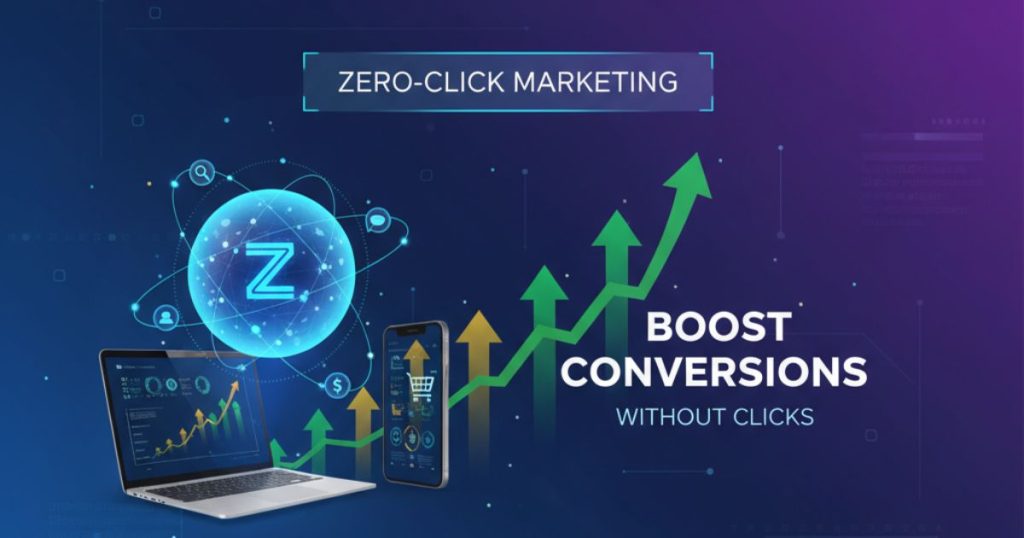Zero-Click Marketing: Winning the SERPs with Content That Converts Without Clicks

Users want fast answers. They prefer information directly on the search results page. They no longer want to open multiple tabs or scroll through long pages. This shift has created the rise of zero-click marketing.
Today, Google and other search engines deliver instant answers through featured snippets, knowledge panels, People Also Ask (PAA) boxes, AI Overviews, and voice search responses. These SERP features provide direct information without requiring a website visit.
Zero-click marketing focuses on giving users helpful, complete, and trustworthy answers right on the SERP. Instead of chasing clicks only, brands now optimize for visibility, authority, and top-of-funnel trust. Even when users don’t click, your content can still influence decisions, shape brand perception, and drive conversions later.
This approach aligns with the future of search. Search engines now prioritize semantic relevance, topical authority, and user intent satisfaction. With the rise of Generative Search (SGE) and AI-powered results, creating rich, structured, context-aware content is more important than ever.
Zero-click SEO is not about losing traffic. It is about gaining presence, trust, and brand recall even before the click happens. When your content answers questions directly on the SERP, you win the moment of intent. And that moment shapes conversions across the entire customer journey.
What is Zero-Click Marketing?
Zero-click marketing is the practice of creating content that gives users answers directly on the search results page. Users get what they need without clicking on a website. Search engines now show instant information through featured snippets, answer boxes, knowledge panels, AI Overviews, and voice search responses. These placements often solve the user’s query on the SERP itself.
Instead of focusing only on rankings or click-through rates, zero-click marketing aims to win high-intent SERP features. The goal is to appear at the top of the page, deliver short and clear answers, and build trust fast. When your content becomes the direct source that Google uses, your brand gains visibility and authority even without a visit.
This approach supports semantic search and Generative Engine Optimization (GEO). Search engines reward content that is structured, fact-based, and aligned with user intent. By satisfying queries instantly, brands strengthen credibility, increase repeat searches, and drive assisted conversions later in the customer journey—through brand recall, navigational searches, or return visits.
Zero-click marketing does not reduce value. It shifts the strategy toward immediate usefulness, topical authority, and SERP dominance. When your content becomes the “answer,” you win influence at the exact moment users are searching.
The Rise of Zero-Click Searches

Zero-click searches are growing very fast. Recent industry studies show that more than half of all Google searches now end without a click to any external website. Users want quick, direct answers. They prefer results they can read or hear instantly. Mobile search, AI-driven results, and Voice Search make this shift even stronger because people expect fast, simple, glanceable information.
Search engines support this behavior by expanding SERP features. Featured snippets continue to grow by more than 20 percent every year. People Also Ask (PAA) boxes appear in almost one out of every four search interactions. Knowledge panels, AI Overviews, local packs, and other rich results reduce the need for users to leave the page.
As Google and other engines focus on keeping users on the SERP, zero-click behavior will rise even more. This creates a major change for marketers. Traditional click-based SEO is no longer enough. Brands must focus on SERP visibility, topical authority, and direct answer delivery. They must also improve Voice Search Optimization, because many zero-click responses now come from spoken answers delivered by smart speakers and mobile assistants.
For marketers, this means embracing semantic search, Generative Engine Optimization (GEO), and structured content that matches user intent. When your content powers the snippet, the PAA answer, the AI summary, or the Voice Search response, your brand wins attention—even without a website visit.
Key Zero-Click Features to Target
Zero-click marketing focuses on taking over the SERP features where users get answers instantly. These features appear across Google Search, AI Overviews, Bing Copilot, and voice assistants. When your content wins these placements, you build visibility, trust, and brand authority—without relying on traditional link clicks.
Search engines now prioritize fast answers, structured information, and contextual relevance. This shift creates new opportunities for brands that optimize their content for rich results, entity-based SEO, and semantic search.
Below are the most important zero-click features to target and how you can optimize for each one.
1. Featured Snippets (Position Zero)
Featured snippets appear above the organic results and give quick answers to user questions. They also feed into AI-generated answers, voice assistants, and zero-click search previews.
Types of featured snippets:
-
Paragraph snippets
-
Numbered lists
-
Bulleted lists
-
Table snippets
Why they matter:
Featured snippets deliver high impressions, boost brand recall, and signal expertise. Even with no clicks, your brand becomes the “default authority” in your niche.
How to optimize:
-
Add clear definitions at the start of sections
-
Use short answer blocks (40–60 words)
-
Add step-by-step lists for “how-to” searches
-
Use simple language and sentence structure
-
Add schema markup for FAQ and HowTo content
2. Knowledge Panels
Knowledge panels show factual data about brands, organizations, products, or public figures. They appear on the right-hand side on desktop and at the top on mobile.
Why they matter:
They help you build authority inside Google’s Knowledge Graph. When search engines recognize your brand as an entity, you gain stronger visibility in zero-click environments, AI Overviews, and voice search.
How to optimize:
-
Use structured data markup (Organization, Product, Person)
-
Claim and update your Google Business Profile
-
Maintain consistent NAP (name–address–phone) information
-
Publish expert-level content that builds trust
-
Get citations from authoritative websites, Wikipedia, Wikidata
3. Answer Boxes & People Also Ask (PAA)
Google’s People Also Ask (PAA) boxes show related questions and short, expandable answers. These results dominate informational search queries and influence how AI systems understand topics.
Why they matter:
Users often get information directly from PAA without clicking a website. Ranking here increases visibility and positions your brand as a helpful resource.
How to optimize:
-
Add FAQ sections using real search queries
-
Use question-based H2 and H3 headings
-
Answer each question in one sentence, then give a short explanation
-
Use crisp, structured formatting
-
Add FAQ schema markup to help search engines crawl your Q&As
4. Voice Assistant Responses
Voice assistants like Google Assistant, Siri, and Alexa depend on short, clear answers. Zero-click queries are even more common here because users hear only one spoken result.
Why they matter:
If your content becomes the selected answer, you “own” the search result for voice-driven intent and gain strong visibility in Voice Search.
How to optimize:
-
Write short, conversational explanations
-
Add structured data such as FAQ, HowTo, and Speakable schema
-
Use natural-language questions and simple phrasing
-
Keep sentences easy for devices to read aloud
-
Match headers to common query patterns like “how,” “what,” “who,” “why,” and “when” to support Voice Search Optimization.
5. Image Carousels & Video Thumbnails
Visual search results are becoming more important with Google Lens, Discover, and AI-powered SERPs. Image packs and video previews often appear before traditional organic listings.
Why they matter:
High-quality visuals increase engagement and brand exposure, even without website visits. Videos also appear prominently in mobile results and YouTube search, which is a major discovery channel.
How to optimize:
-
Use descriptive, keyword-rich alt text
-
Add image schema and video schema
-
Use high-resolution images with clean composition
-
Create strong video titles, tags, and thumbnails
-
Add contextual captions and timestamps for video SEO
These elements boost visual search performance and strengthen brand recognition.
Why Zero-Click Marketing Matters for Brands?
Zero-click marketing is becoming essential as search behavior shifts toward instant answers and AI-generated results. When users get information directly on the SERP, brands must adapt to stay visible, relevant, and trusted—even without a traditional website click.
Here’s why zero-click marketing is so important for modern businesses:
1. Builds Instant Authority and Trust
Zero-click features place your brand in top positions such as featured snippets, knowledge panels, and PAA boxes. These placements show users that Google trusts your content. When your brand provides fast, accurate answers, you become a reliable authority in your industry.
2. Increases Organic Impressions at Scale
Position-zero results appear across multiple search variations, long-tail queries, and question-based searches. This expands your brand’s exposure far beyond a single keyword. Even if users don’t click, they still see your brand name, answer, and credibility.
3. Strengthens the Full Customer Journey
Zero-click interactions often influence downstream behavior. When users see your brand directly in the SERP, they are more likely to:
-
Conduct branded searches later
-
Visit your website directly
-
Engage with your products on social or marketplaces
-
Convert when they are ready to buy
Zero-click marketing boosts awareness and supports upper- and mid-funnel campaigns.
4. Future-Proofs Strategy Against Privacy Shifts
With third-party cookies disappearing and privacy rules tightening, traditional tracking and targeting are becoming harder. Zero-click placements offer privacy-safe visibility because they rely on content quality, structured data, and semantic relevance—not behavioral tracking.
This makes zero-click SEO a durable, long-term strategy.
5. Aligns With AI Search and Generative Engines
Generative engines like Google AI Overviews, Bing Copilot, and Perplexity pull information from structured, concise, and authoritative content. Zero-click optimization naturally prepares your content for these AI-driven experiences.
Brands that optimize for zero-click now will dominate in AI search later.
Strategies to Optimize for Zero-Click
Winning zero-click placements requires a blend of technical SEO, structured content, and user-centric optimization. The goal is to give search engines clear, direct, and trustworthy answers they can display instantly on the SERP. These strategies help you capture featured snippets, PAA results, voice answers, and visual placements.
1. Identify High-Intent Queries
Start by researching question-based and long-tail keywords that naturally trigger zero-click results. These include:
-
“What is…” definitions
-
“How to…” guides
-
“Why does…” explanations
-
Comparisons (e.g., “A vs B”)
Use tools like Google Search Console, AnswerThePublic, and Semrush to find queries that already show:
-
Featured snippets
-
People Also Ask questions
-
AI Overview summaries
Targeting informational and transactional intent boosts your chances of ranking in top SERP features.
2. Structure Content for Clarity
Search engines prefer clean, scannable content. Use a clear content hierarchy:
-
H2 for main sections
-
H3/H4 for subtopics
-
Bullet points and numbered lists for steps
This structure helps Google understand your page and extract information for snippets, PAA boxes, and voice search.
3. Implement Schema Markup
Schema markup helps search engines interpret your content and match it to relevant SERP features. Use:
-
FAQ Schema (for FAQs)
-
Q&A Schema (for community-style answers)
-
HowTo Schema (for step-by-step instructions)
-
Product Schema (for e-commerce)
-
Organization Schema (for entity building)
Schema increases eligibility for rich results, voice search selection, and AI-powered responses.
4. Optimize Answer Length and Placement
Place short, direct answers immediately under the relevant heading. Keep them concise:
-
40–60 words for featured snippets
-
One-sentence answers for PAA results
-
Conversational tone for voice search
After the short answer, add deeper explanation, examples, and context. This helps you satisfy both zero-click SERPs and user engagement.
5. Leverage Multimedia for SERP Visibility
Zero-click search is increasingly visual. Include:
-
High-quality images
-
Short videos
-
Infographics
-
Visual step-by-step guides
Optimize visuals with:
-
Descriptive file names
-
Alt text with keywords
-
Image schema
-
Video transcripts and timestamps
These improve your chances of ranking in image carousels, video thumbnails, and visual search results.
6. Focus on Mobile and Voice Experience
Most zero-click answers come from mobile and voice queries. Ensure:
-
Mobile-friendly formatting
-
Large, readable fonts
-
Short paragraphs
-
Conversational language
-
Clear answers suited for spoken delivery
Test how your page is read by tools like Google Assistant or screen readers to ensure proper extraction.
Measuring Zero-Click Success
Traditional click-through metrics often fail to capture the full impact of zero-click placements, since users can receive the information they need directly on the SERP without visiting a website. To accurately measure performance, brands should evaluate a broader set of indicators that reveal how zero-click visibility influences awareness, engagement, and downstream behavior.
1. SERP Impressions
Monitor impression trends in Google Search Console to understand how frequently your content is being surfaced in position-zero elements. Rising impressions signal greater visibility for targeted queries, even when clicks remain flat, indicating that users are consuming your information directly within Google’s interface.
2. Ranking Volatility & SERP Feature Ownership
Use advanced SEO tools to track how consistently your content appears in high-value zero-click placements such as featured snippets, People Also Ask boxes, knowledge panels, and AI summaries. Monitoring volatility helps identify when competitors take over your position and highlights opportunities to reinforce content relevance or improve structured data.
3. Branded Search Uplift
Analyze trends in branded keyword volume to measure downstream impact. Users who first encounter your information in a zero-click result often return later to search for your brand directly. A sustained increase in branded queries suggests stronger brand recall and a higher likelihood of intentional engagement.
4. Voice Interaction Metrics
As zero-click content increasingly powers voice assistants, use voice analytics platforms to evaluate how often your information is cited or read aloud by smart speakers and virtual assistants. Voice-driven impressions and completions provide insight into how your brand performs in conversational search environments.
5. Indirect Click-Through & Assisted Conversions
Zero-click interactions often influence behavior without producing an immediate click. By analyzing multi-touch journeys in analytics tools, you can measure delayed site visits, organic return traffic, and assisted conversions that occur after users initially interacted with your content on the SERP. This helps quantify the long-term value of presence in zero-click ecosystems.
Case Studies & Examples
1. Healthline — Dominating Featured Snippets in Healthcare
Healthline is one of the biggest winners of zero-click SEO in the medical space.
They consistently take the top answer boxes for searches like:
-
“benefits of yoga”
-
“symptoms of vitamin D deficiency”
-
“how much water should you drink”
Why they succeed:
-
They use clear 40–60-word definitions at the top of articles.
-
Their content follows strong medical review processes (high authority).
-
They use structured formatting: bullet lists, headings, symptoms tables.
Impact:
Even if users don’t click, Healthline appears as the “trusted answer,” strengthening brand recognition, repeat searches, and voice-assistant visibility.
2. HubSpot — Featured Snippets + Topic Cluster Strategy
HubSpot uses a “pillar page + cluster content” model that Google loves for zero-click queries.
This helps them rank for questions like:
-
“what is CRM”
-
“what is inbound marketing”
-
“how to write a marketing plan”
Why they win:
-
Every article starts with a short, clear answer block.
-
They use FAQ sections and schema markup.
-
They break content into scannable sections for AI and search crawlers.
Impact:
HubSpot frequently appears in snippets, People Also Ask results, and voice responses — reinforcing their industry authority even without a click.
3. Mayo Clinic — Authority + Clarity in Medical SERPs
Mayo Clinic’s content is medically verified and extremely structured, which makes it ideal for:
-
Answer boxes
-
Definition snippets
-
Voice assistant answers
Examples of queries they often appear for:
-
“what is pneumonia”
-
“symptoms of diabetes”
Why they win:
-
Strong domain authority
-
Clear, direct explanations
-
Expert-backed content
Impact:
Their zero-click visibility boosts trust and positions them as a top healthcare reference globally.
4. NerdWallet — Finance Answers in PAA & Snippets
NerdWallet ranks strongly for finance questions like:
-
“how does APR work”
-
“credit score ranges”
-
“best travel credit cards”
Why they succeed:
-
Direct, one-sentence definitions
-
High-quality comparison tables
-
Question-based content structure
-
FAQ schema to target PAA boxes
Impact:
NerdWallet gains massive brand exposure even when users read the answer directly on Google and don’t visit the site.
5. Tripadvisor — FAQ + Schema for Travel Queries
Tripadvisor appears frequently in Google’s:
-
FAQ rich results
-
PAA answers
-
Local travel information panels
Queries they often win:
-
“best time to visit Bali”
-
“top hotels in Dubai”
Why they win:
-
Massive user-generated content
-
Clear list formats
-
Consistent updates
-
Strong structured data markup
Impact:
Travelers see Tripadvisor’s name repeatedly in SERPs, increasing likelihood of branded searches later.
6. Shopify — “How-To” Snippets for E-commerce
Shopify invests heavily in content that answers merchants’ questions directly, such as:
-
“how to start an online store”
-
“what is dropshipping”
-
“how to sell products online”
Why they succeed:
-
Step-by-step formats perfect for snippets
-
HowTo schema
-
Concise definitions under headings
Impact:
Shopify dominates zero-click e-commerce queries, strengthening its brand among entrepreneurs.
Best Practices and Common Pitfalls
Zero-click marketing delivers strong visibility, but it must be executed carefully. Follow these best practices to stay competitive while avoiding common mistakes.
1. Avoid Keyword Stuffing
Do not overload your content with repetitive keywords.
Over-optimization can cause:
-
Loss of featured snippet positions
-
Reduced visibility in AI Overviews
-
Algorithmic demotion or even manual penalties
Use natural language. Add semantic variations, related entities, and topic-rich terms instead of repeating the same keyword.
2. Maintain Content Depth and Expertise
Short answers help you win snippets, but depth keeps your authority strong.
Provide:
-
Detailed explanations
-
Examples
-
Visuals
-
Step-by-step guides
This ensures that users who click for more context find valuable information. Search engines also reward pages that combine concise answers with comprehensive depth, improving topical authority.
3. Regularly Audit SERP Features
Google’s SERP features change constantly. AI Overviews, PAA boxes, snippets, and visual packs evolve based on query trends.
To stay relevant:
-
Run quarterly content audits
-
Update outdated sections
-
Refresh schema markup
-
Improve clarity in structured content
Consistent updates help you maintain or regain position-zero visibility.
4. Balance Zero-Click and Click-Through Goals
Zero-click visibility should support—not replace—your website traffic goals.
Use this strategy to:
-
Build brand recognition on the SERP
-
Increase repeat search behavior
-
Strengthen authority for future conversions
But also create clear pathways for users who need more details, tools, or product pages. Zero-click and click-based funnels should work together to increase overall ROI.
The Future of Zero-Click Marketing

Zero-click marketing is entering a new phase as search engines become smarter, more conversational, and more personalized. AI models such as BERT, MUM, and multimodal search systems now understand user intent, behavior, and context more accurately. This makes search results richer, more visual, and more immediate.
AI can read user needs in real time. It can consider location, search history, and preferences. This helps search engines deliver precise answers without requiring a click. We are already seeing AI summaries, contextual carousels, and interactive modules in the SERP. These features keep users on the results page longer.
As search becomes multimodal—combining text, images, voice, and video—brands must optimize content across different formats. Zero-click opportunities now appear not only on the SERP but also in:
-
AI assistants and chat interfaces
-
Voice search on smart speakers
-
AR tools and visual scanning apps
-
In-app search inside shopping, social, and map platforms
To succeed, brands must update schema in real time, optimize dynamic content, and create short, voice-friendly answers. Brands also need structured knowledge systems that AI models can easily understand and reuse. This helps build a strong brand ecosystem where all content works together across platforms.
As search becomes more ambient and seamless, zero-click marketing will shift from a simple SEO technique to a full visibility strategy. It will support every part of the brand ecosystem—web, mobile, apps, social, and smart devices. The brands that win will deliver fast answers, clear value, and high trust everywhere the user is, without relying on clicks.
Conclusion
Zero-click marketing marks a major evolution in how brands connect with audiences on the search results page. Instead of relying only on traditional clicks, brands must now deliver value directly on the SERP through featured snippets, knowledge panels, People Also Ask responses, voice search answers, and visual search elements. These placements help you capture high-intent attention, build authority, and increase brand visibility—even when users never visit your website.
Success in a zero-click environment requires structured content, strong schema markup, and a clear focus on user intent. It also demands new performance metrics, including impression growth, snippet ownership, branded search lift, and assisted conversions. When used effectively, zero-click content strengthens trust, improves multi-channel performance, and supports the entire customer journey.
As search engines and AI-driven assistants continue to prioritize fast, direct answers, brands that embrace zero-click strategies today will lead the competition tomorrow. Adopt the clickless mindset, optimize your content for modern SERP features, and position your business for long-term visibility in an increasingly frictionless digital world.
FAQs
What is Zero-Click Marketing?
Zero-click marketing means giving users answers directly on the search results page. They do not need to visit a website. Brands focus on featured snippets, PAA boxes, and other SERP features. This helps people get fast information and helps brands gain visibility without a click.
Why Are Zero-Click Searches Increasing?
Zero-click searches are growing because people want quick answers. Mobile users and voice search users prefer short, direct responses. Google now shows more snippets, answer boxes, and AI results. These features solve many questions instantly, so users do not click as often.
How Can Brands Optimize for Zero-Click Results?
Brands can optimize by answering common questions clearly. Use simple headings, short paragraphs, and bullet points. Add schema markup like FAQ, HowTo, and Product. Keep answers between 40 and 60 words. Use good images and clear alt text to appear in visual results too.
Does Zero-Click SEO Reduce Website Traffic?
Zero-click SEO may reduce some clicks, but it increases brand visibility. When users see your answers on the SERP, they remember your brand. Many users return later with branded searches. This improves trust and helps conversions over time.
How Do You Measure Zero-Click SEO Success?
You can measure zero-click success by checking impressions in Google Search Console. Track how often you appear in snippets, PAA, or other SERP features. Watch for growth in branded searches. Also check assisted conversions to see if users come back later and complete an action.





